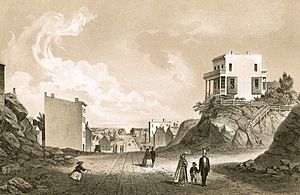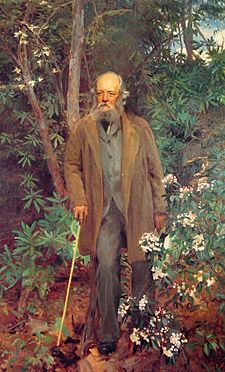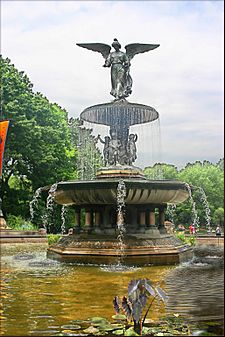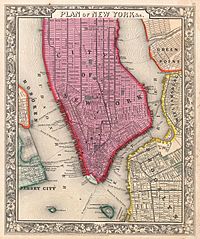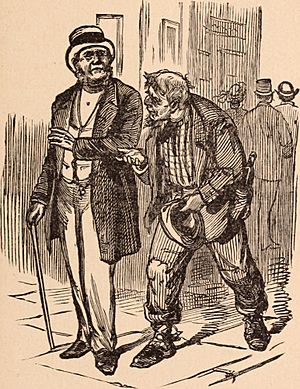History of New York City (1855–1897) facts for kids
The history of New York City (1855–1897) tells the story of New York City during an important time. This period began in 1855 when Fernando Wood became mayor. He was the first mayor from Tammany Hall, a powerful political group that controlled the city for many years.
During these years, New York City grew a lot. More people moved there, especially immigrants. New technologies like steamships and railroads helped the city become a major center for trade and industry. The city also saw big changes, including the American Civil War and a time of great wealth called the Gilded Age. This era also saw the start of what would become the five boroughs of New York City.
Contents
New York Before the Civil War
Staten Island Quarantine War
From 1800 to 1858, Staten Island had the biggest quarantine hospital in the United States. This was a place where sick people, especially immigrants, were kept to stop diseases from spreading.
However, local residents were very unhappy about it. In 1858, angry people burned down the hospital buildings. This event is known as the Staten Island Quarantine War. Luckily, no one died, but the hospital was completely destroyed.
Building Central Park
As New York City grew, especially in Lower Manhattan, people wanted more green spaces. Middle-class families often went to cemeteries to escape the city's noise and smells.
Artists like Asher B. Durand and William Cullen Bryant believed in the healing power of nature. They, along with architect Andrew Jackson Downing, dreamed of a large park. In 1853, the state government provided $5 million to buy land for what would become Central Park.
Egbert L. Viele drew the first plans. But Frederick Law Olmsted and Calvert Vaux created the final design, called the Greensward Plan. They are given most of the credit for the park's look.
Central Park's design was very new. It had separate paths for people walking, horseback riders, and carriages. Roads for business traffic were hidden below ground. This helped keep the park feeling natural and peaceful.
Central Park was the first great urban park in the United States. Olmsted taught Americans new ideas about parks and city planning. He showed how parks could be designed to feel like real nature, even in a busy city.
New York During the Civil War
Before the Civil War started in 1861, Mayor Wood suggested that New York City should become its own neutral country. He called it Tri-Insula. This idea was meant to keep the city out of the war, but it was not popular.
New York City played a big role in the Union Army's efforts. It provided many soldiers, supplies, and money. The port of New York was a main entry point for immigrants. Many of these new arrivals were recruited into the Army.
In July 1863, there were huge protests against the draft (when people are forced to join the army). These protests, known as the "Draft Riots", lasted five days. They were the worst riots in American history. The rioters mainly targeted Black people and wealthy Republicans. The U.S. Army had to use cannons to stop the riots, which sadly killed and wounded many people.
Meanwhile, a group called the New York Union League Club helped recruit over 2,000 Black men for the 20th United States Colored Infantry. This helped the Union Army and was a big step for African American civil rights. The nearby city of Brooklyn was more supportive of the war.
In 1865, the fire departments of New York and Brooklyn joined together. This led to the creation of the New York City Fire Department.
Tourism and Entertainment
New York City became a major center for tourism and entertainment in the country. Large, fancy hotels were built for visitors. The city's theater district slowly moved north over these years. It started in The Bowery and moved up Broadway, eventually settling around Times Square by the late 1800s. Famous actors like Edwin Booth and Lillian Russell performed on Broadway stages.
The Gilded Age
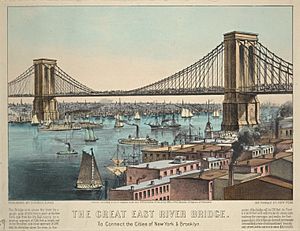
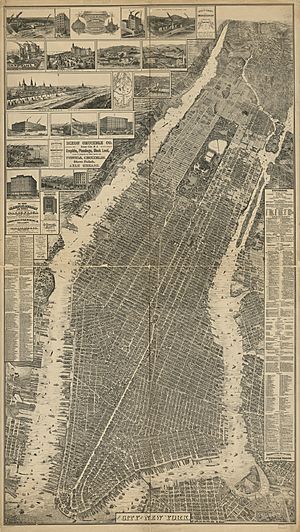
After the Civil War, New York City saw a time of great wealth for some, but also growing poverty for others. This period was called the Gilded Age. It was known for political corruption, but also for the creation of important cultural places. These included the Metropolitan Museum of Art and the Metropolitan Opera. The Brooklyn Museum was also a major institution in New York's sister city, Brooklyn.
Many older libraries joined to form the New York Public Library. The New York Academy of Sciences also grew and helped create places like the New York Botanical Garden and the American Museum of Natural History.
New York newspapers, like the New York Tribune, were read all over the country.
As more immigrants arrived, poverty also increased. The poorest people lived in crowded, low-cost housing in areas like the Five Points and Hell's Kitchen. These crowded conditions helped germs spread, and death rates were much higher in these city homes than in the countryside.
City Transportation
As the city spread out, middle-class people needed to travel further for work and shopping. Working-class people usually walked to nearby factories and shops.
In the 1880s, horse-drawn streetcars and faster electric trolleys became popular. Before paved roads, streets were dirt or gravel. This made them uneven and dangerous for walking or riding. In 1900, Manhattan alone had 130,000 horses pulling wagons and carriages. They left a lot of waste on the streets.
Cities wanted better roads, so they started paving them with wood or granite blocks. By the end of the century, American cities had millions of square yards of asphalt paving. Electric trolleys moved at about 12 miles per hour and became the main way for middle-class people to get around.
In the biggest cities, some street railways were built above the streets. This made them faster and safer. Boston built the first subway in the 1890s, and New York followed about ten years later.
Immigration to New York
Most European immigrants first arrived in New York Harbor. They passed through Castle Clinton (opened 1855) and later Ellis Island (opened 1892). The Statue of Liberty opened nearby in 1886. Many immigrants traveled to other parts of the country, but many also made New York City their new home.
This wave of European immigration brought big social changes. Housing, especially in Lower Manhattan, became very crowded. New buildings called tenements were built, and many people lived in flimsy shacks. Italians settled around Mulberry Street, in an area later known as "Little Italy." Many Yiddish-speaking Jewish people from Eastern Europe moved to the Lower East Side.
In July 1871 and 1872, there were clashes called the Orange Riots. These happened when Catholic Irish people tried to stop Protestant Irish people from celebrating an important anniversary. More than 33 people died, and many were hurt.
A famous photojournalist named Jacob Riis showed the terrible living conditions of immigrants in his 1890 book, How the Other Half Lives. He became friends with a reformer named Theodore Roosevelt. Roosevelt tried to become mayor in 1886 but lost. However, reformers did win in 1894. Roosevelt then worked to improve the New York City Police Department from 1895 to 1897.
Public Health
Diseases like typhus, cholera, diphtheria, and tuberculosis were common in the city's poor areas. Streets were often covered in horse manure. In winter, when everything froze, walking was very difficult. Dead animals sometimes stayed on the streets for weeks. In 1894, Colonel George E. Waring Jr. started major clean-up efforts. He used a large team to clean the streets, which greatly improved public health.
City Politics
Tammany Hall's Influence
William Tweed, also known as Boss Tweed, became the main leader of Tammany Hall by 1867. From 1870, he and his friends used their power to misuse millions of dollars from the city. A famous example was the very expensive building of the Tweed Courthouse.
Reformers, including Democratic politicians like Samuel J. Tilden and newspaper editors with strong cartoons by Thomas Nast, helped elect new leaders in 1871. Tweed was found guilty of misusing money in 1873. His downfall showed that corrupt political leaders could be held responsible. This helped lead to later reforms in the city.

Tammany Hall recovered quickly after Tweed's fall. "Honest John" Kelly was chosen as the new leader. Kelly was not involved in Tweed's scandals and was a respected Catholic. He removed Tweed's supporters and made Tammany Hall stronger. His success meant that in the 1874 election, the Tammany candidate won, giving control of the city back to Tammany Hall.
Theodore Roosevelt, who later became president, was very involved in New York City politics. He explained how the political machine worked:
- The way a party is set up in our city is a lot like an army. There's one big boss, with some trusted helpers. These helpers talk to the different district bosses, whom they both push and support. The district boss then has people under him who choose the election district captains, and so on, who then connect with the regular voters.
New York's Economy
By 1874, almost 61% of all U.S. goods sent to other countries passed through New York harbor. In 1884, nearly 70% of goods coming into the U.S. arrived through New York. Later, other ports grew, but New York remained a major center for trade.
The city's banking resources grew a lot between 1888 and 1908. The value of land and buildings in Manhattan also increased greatly, from $1.7 billion in 1860 to $6.7 billion in 1907.
New York City and its nearby areas, like Brooklyn and Long Island City, also became important for light industry. Its factories were leaders in the garment industry (making clothes) and new technologies like sewing machines and pianos. It was also a center for other high-tech items and chemical works.
Department Stores
In the mid-1800s, department stores started to appear in big cities. These stores changed how people shopped and what they expected from customer service. New York became a popular place for shoppers from all over the country.
In 1846, Alexander Turney Stewart opened his "Marble Palace" on Broadway. He sold fancy goods at set prices. The building looked like a grand palace, but it had large windows that allowed for big displays, especially during the Christmas shopping season. More and more, wealthy women became the main customers.
In 1862, Stewart built an even bigger store. It had eight floors and many different departments, from clothes to toys. His new ideas included buying goods in large amounts for cash, keeping prices low, being honest about products, having one set price (no haggling), easy returns, and offering free services like waiting rooms and delivery. Other department stores quickly copied his ideas.
In 1858, Rowland Hussey Macy started Macy's as a dry goods store. Other stores like Benjamin Altman's and Lord & Taylor soon competed with Stewart.
By the 1880s, New York's main shopping area moved uptown. This area was called the "Ladies' Mile." By 1894, stores competed with amazing Christmas window displays. Macy's, for example, had 13 different scenes, including ones from Jack and the Beanstalk.
Department stores were especially important for women. In middle-class families, women often did the shopping. These stores catered to their tastes. Also, young women could find jobs as clerks, where they learned social skills to work with customers.
Skyscrapers and Apartment Buildings
New inventions in the 1880s led to the rise of the skyscraper. This tall building style became a unique American feature. Building skyscrapers needed big changes, like the elevator and structural steel. Steel frames, developed in the 1880s, replaced heavy brick walls. Brick buildings could only be about 15 stories tall. Skyscrapers also needed complex systems for air, heat, lighting, and plumbing.
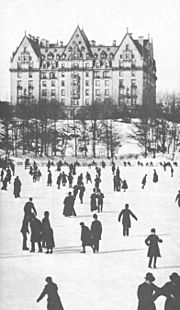
New York City had many types of homes. Most attention was on tenements for the working class and apartment buildings for the middle class. Apartment buildings came first. Middle-class workers realized they didn't need or couldn't afford large single-family dwellings in the city's expensive areas.
Starting with the fancy Stuyvesant Apartments in 1869 and the even grander The Dakota in 1884, wealthy residents hired staff to handle upkeep and security.
Less fancy middle-class apartment buildings had gas lighting, elevators, good plumbing, central heating, and maintenance staff. These buildings were built along streetcar lines, as middle-class people rode the streetcar to work.
The working class lived in crowded tenement houses. These had fewer features and comforts. Novelist Stephen Crane wrote about an Irish tenement neighborhood in his 1893 book, Maggie: A Girl of the Streets. He described it as a place with poverty and violence.
Tenements were cheap and easy to build. They often filled almost the entire lot. They were usually five stories tall, with four apartments on each floor. There was little fresh air or sunlight. Until a law in 1879, new tenements didn't have running water or indoor toilets. A law in 1901 required older tenements to add indoor plumbing. Garbage collection was not regular until later in the 1800s. Rent was cheap, but people had to deal with dust, clutter, smells, and noise. Most tenements remained until the 1950s.
City Neighborhoods
Before the Civil War, steam ferries had already made Brooklyn Heights a popular place for wealthy professionals who worked on Wall Street. Elevated railroads and other new public transport helped New York's commuter area grow. This allowed new neighborhoods for people with less money to develop in areas like the Upper West Side. Plans were also made for subways to reach even further areas like Harlem and the West Bronx.
In the late 1800s, the hard rock under Manhattan helped build the early skyscrapers that define the city's skyline today. The Great Blizzard of 1888 showed how easily the city's systems could fail. This led to plans to put electric and telephone lines underground, and also encouraged the idea of a subway system.
City Consolidation
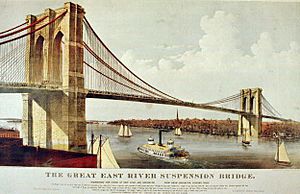
In 1855, the City of Brooklyn added Williamsburg and Bushwick. This made Brooklyn the third most populated city in America. In 1870, Long Island City was formed in Queens. In 1874, New York City added the West Bronx, which is west of the Bronx River.
The Brooklyn Bridge, finished in 1883, was a symbol of the era's confidence. It brought the cities of Brooklyn and New York closer together. As Brooklyn added the rest of Kings County between 1886 and 1896, the idea of joining all these areas became more important.
The modern city of Greater New York — made up of the five boroughs — was created in 1898. This happened when the cities of New York (which was then Manhattan and the Bronx) and Brooklyn joined with the mostly rural areas of Queens and Staten Island.
Timeline
| Preceded by History of New York City (1784–1854) |
History of New York City (1855–1897) |
Succeeded by History of New York City (1898–1945) |
See also
 In Spanish: Historia de Nueva York (1855-1897) para niños
In Spanish: Historia de Nueva York (1855-1897) para niños



